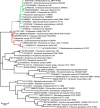Resolving taxonomic confusion: establishing the genus Phytobacter on the list of clinically relevant Enterobacteriaceae
- PMID: 35169969
- PMCID: PMC8934334
- DOI: 10.1007/s10096-022-04413-8
Resolving taxonomic confusion: establishing the genus Phytobacter on the list of clinically relevant Enterobacteriaceae
Abstract
Although many clinically significant strains belonging to the family Enterobacteriaceae fall into a restricted number of genera and species, there is still a substantial number of isolates that elude this classification and for which proper identification remains challenging. With the current improvements in the field of genomics, it is not only possible to generate high-quality data to accurately identify individual nosocomial isolates at the species level and understand their pathogenic potential but also to analyse retrospectively the genome sequence databases to identify past recurrences of a specific organism, particularly those originally published under an incorrect or outdated taxonomy. We propose a general use of this approach to classify further clinically relevant taxa, i.e., Phytobacter spp., that have so far gone unrecognised due to unsatisfactory identification procedures in clinical diagnostics. Here, we present a genomics and literature-based approach to establish the importance of the genus Phytobacter as a clinically relevant member of the Enterobacteriaceae family.
Keywords: Genomics; Identification; Phytobacter diazotrophicus; Phytobacter palmae; Phytobacter ursingii; Taxonomy.
© 2022. The Author(s).
Conflict of interest statement
The authors declare no competing interests.
Figures



Similar articles
-
Proposal for Unification of the Genus Metakosakonia and the Genus Phytobacter to a Single Genus Phytobacter and Reclassification of Metakosakonia massiliensis as Phytobacter massiliensis comb. nov.Curr Microbiol. 2020 Aug;77(8):1945-1954. doi: 10.1007/s00284-020-02004-4. Epub 2020 Apr 30. Curr Microbiol. 2020. PMID: 32350604
-
Genomic insights into the evolution, pathogenicity, and extensively drug-resistance of emerging pathogens Kluyvera and Phytobacter.Front Cell Infect Microbiol. 2024 Mar 21;14:1376289. doi: 10.3389/fcimb.2024.1376289. eCollection 2024. Front Cell Infect Microbiol. 2024. PMID: 38577620 Free PMC article.
-
Emended description of the genus Phytobacter, its type species Phytobacter diazotrophicus (Zhang 2008) and description of Phytobacter ursingii sp. nov.Int J Syst Evol Microbiol. 2018 Jan;68(1):176-184. doi: 10.1099/ijsem.0.002477. Epub 2017 Nov 10. Int J Syst Evol Microbiol. 2018. PMID: 29125457
-
Can whole genome analysis refine the taxonomy of the genus Rhodococcus?FEMS Microbiol Rev. 2004 Jun;28(3):377-403. doi: 10.1016/j.femsre.2004.01.001. FEMS Microbiol Rev. 2004. PMID: 15449609 Review.
-
Modern taxonomy of biotechnologically important Aspergillus and Penicillium species.Adv Appl Microbiol. 2014;86:199-249. doi: 10.1016/B978-0-12-800262-9.00004-4. Adv Appl Microbiol. 2014. PMID: 24377856 Review.
Cited by
-
Phytobacter spp: the emergence of a new genus of healthcare-associated Enterobacterales encoding carbapenemases in Argentina: a case series.Infect Prev Pract. 2024 Jun 10;6(3):100379. doi: 10.1016/j.infpip.2024.100379. eCollection 2024 Sep. Infect Prev Pract. 2024. PMID: 39006243 Free PMC article.
-
Emergence of Phytobacter diazotrophicus carrying an IncA/C2 plasmid harboring bla NDM-1 in Tokyo, Japan.mSphere. 2023 Aug 24;8(4):e0014723. doi: 10.1128/msphere.00147-23. Epub 2023 Jul 14. mSphere. 2023. PMID: 37449846 Free PMC article.
-
Genomic Identification of Two Phytobacter diazotrophicus Isolates from a Neonatal Intensive Care Unit in Singapore.Microbiol Resour Announc. 2023 Jun 20;12(6):e0016723. doi: 10.1128/mra.00167-23. Epub 2023 May 11. Microbiol Resour Announc. 2023. PMID: 37166299 Free PMC article.
-
Sepsis caused by Phytobacter diazotrophicus complicated with galactosemia type 1 in China: a case report.BMC Infect Dis. 2024 Jun 19;24(1):599. doi: 10.1186/s12879-024-09458-y. BMC Infect Dis. 2024. PMID: 38898413 Free PMC article.
-
Gram-negative sepsis caused by a rare pathogen Phytobacter ursingii.BMJ Case Rep. 2024 Apr 16;17(4):e258384. doi: 10.1136/bcr-2023-258384. BMJ Case Rep. 2024. PMID: 38627051 Free PMC article.
References
-
- Skerman VBD, McGowan V, Sneath PHA. Approved lists of bacterial names. Int J Syst Bacteriol. 1980;30(1):225–420. - PubMed
-
- Adeolu M, Alnajar S, Naushad S, Gupta RS. Genome-based phylogeny and taxonomy of the ‘Enterobacteriales’: proposal for Enterobacterales ord. nov. divided into the families Enterobacteriaceae, Erwiniaceae fam. nov., Pectobacteriaceae fam. nov., Yersiniaceae fam. nov., Hafniaceae fam. nov., Morganellaceae fam. nov., and Budviciaceae fam. nov. Int J Syst Evol Microbiol. 2016;66:5575–5599. - PubMed
-
- Alnajar S, Gupta RS. Phylogenomics and comparative genomic studies delineate six main clades within the family Enterobacteriaceae and support the reclassification of several polyphyletic members of the family. Infect Genet Evol. 2017;54:108–127. - PubMed
-
- Rosselló-Móra R, Amann R. Past and future species definitions for Bacteria and Archaea. Syst Appl Microbiol. 2015;38:209–216. - PubMed
Publication types
MeSH terms
LinkOut - more resources
Full Text Sources
Molecular Biology Databases
Miscellaneous

